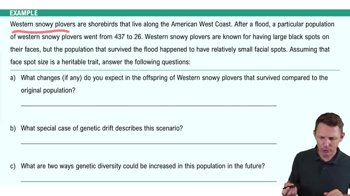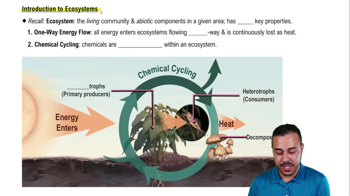- 1. Introduction to Biology2h 40m
- 2. Chemistry3h 40m
- 3. Water1h 26m
- 4. Biomolecules2h 23m
- 5. Cell Components2h 26m
- 6. The Membrane2h 31m
- 7. Energy and Metabolism2h 0m
- 8. Respiration2h 40m
- 9. Photosynthesis2h 49m
- 10. Cell Signaling59m
- 11. Cell Division2h 47m
- 12. Meiosis2h 0m
- 13. Mendelian Genetics4h 41m
- Introduction to Mendel's Experiments7m
- Genotype vs. Phenotype17m
- Punnett Squares13m
- Mendel's Experiments26m
- Mendel's Laws18m
- Monohybrid Crosses16m
- Test Crosses14m
- Dihybrid Crosses20m
- Punnett Square Probability26m
- Incomplete Dominance vs. Codominance20m
- Epistasis7m
- Non-Mendelian Genetics12m
- Pedigrees6m
- Autosomal Inheritance21m
- Sex-Linked Inheritance43m
- X-Inactivation9m
- 14. DNA Synthesis2h 27m
- 15. Gene Expression3h 20m
- 16. Regulation of Expression3h 31m
- Introduction to Regulation of Gene Expression13m
- Prokaryotic Gene Regulation via Operons27m
- The Lac Operon21m
- Glucose's Impact on Lac Operon25m
- The Trp Operon20m
- Review of the Lac Operon & Trp Operon11m
- Introduction to Eukaryotic Gene Regulation9m
- Eukaryotic Chromatin Modifications16m
- Eukaryotic Transcriptional Control22m
- Eukaryotic Post-Transcriptional Regulation28m
- Eukaryotic Post-Translational Regulation13m
- 17. Viruses37m
- 18. Biotechnology2h 58m
- 19. Genomics17m
- 20. Development1h 5m
- 21. Evolution3h 1m
- 22. Evolution of Populations3h 52m
- 23. Speciation1h 37m
- 24. History of Life on Earth2h 6m
- 25. Phylogeny2h 31m
- 26. Prokaryotes4h 59m
- 27. Protists1h 12m
- 28. Plants1h 22m
- 29. Fungi36m
- 30. Overview of Animals34m
- 31. Invertebrates1h 2m
- 32. Vertebrates50m
- 33. Plant Anatomy1h 3m
- 34. Vascular Plant Transport2m
- 35. Soil37m
- 36. Plant Reproduction47m
- 37. Plant Sensation and Response1h 9m
- 38. Animal Form and Function1h 19m
- 39. Digestive System10m
- 40. Circulatory System1h 57m
- 41. Immune System1h 12m
- 42. Osmoregulation and Excretion50m
- 43. Endocrine System4m
- 44. Animal Reproduction2m
- 45. Nervous System55m
- 46. Sensory Systems46m
- 47. Muscle Systems23m
- 48. Ecology3h 11m
- Introduction to Ecology20m
- Biogeography14m
- Earth's Climate Patterns50m
- Introduction to Terrestrial Biomes10m
- Terrestrial Biomes: Near Equator13m
- Terrestrial Biomes: Temperate Regions10m
- Terrestrial Biomes: Northern Regions15m
- Introduction to Aquatic Biomes27m
- Freshwater Aquatic Biomes14m
- Marine Aquatic Biomes13m
- 49. Animal Behavior28m
- 50. Population Ecology3h 41m
- Introduction to Population Ecology28m
- Population Sampling Methods23m
- Life History12m
- Population Demography17m
- Factors Limiting Population Growth14m
- Introduction to Population Growth Models22m
- Linear Population Growth6m
- Exponential Population Growth29m
- Logistic Population Growth32m
- r/K Selection10m
- The Human Population22m
- 51. Community Ecology2h 46m
- Introduction to Community Ecology2m
- Introduction to Community Interactions9m
- Community Interactions: Competition (-/-)38m
- Community Interactions: Exploitation (+/-)23m
- Community Interactions: Mutualism (+/+) & Commensalism (+/0)9m
- Community Structure35m
- Community Dynamics26m
- Geographic Impact on Communities21m
- 52. Ecosystems2h 36m
- 53. Conservation Biology24m
53. Conservation Biology
Conservation Biology
Problem 9a
Textbook Question
What are the three levels of biological diversity? Explain how human activities threaten each of these levels.
 Verified step by step guidance
Verified step by step guidance1
Identify the three levels of biological diversity: Genetic diversity, Species diversity, and Ecosystem diversity. Genetic diversity refers to the variety of genes within a species, species diversity refers to the variety of species within a habitat or region, and ecosystem diversity refers to the variety of ecosystems in a biosphere.
Explain how human activities threaten genetic diversity: Activities such as habitat destruction, pollution, and over-harvesting can reduce the genetic diversity within populations by decreasing population sizes and isolating populations from each other. This can lead to inbreeding and reduced adaptability to environmental changes.
Discuss the impact of human activities on species diversity: Human actions like deforestation, urbanization, and introduction of invasive species disrupt habitats and can lead to species extinction. This reduces the number of species (biodiversity) and can disrupt ecological interactions.
Describe how human activities affect ecosystem diversity: Large-scale changes such as land use change, water diversion, and climate change can alter the structure and function of ecosystems. This can lead to loss of ecosystem services, which are critical for human survival and well-being.
Summarize the overall impact of human activities on biological diversity: By understanding the specific threats to each level of biological diversity, conservation efforts can be better directed to preserve the genetic, species, and ecosystem diversity, which are all crucial for maintaining the planet's health and resilience.
Recommended similar problem, with video answer:
 Verified Solution
Verified SolutionThis video solution was recommended by our tutors as helpful for the problem above
Video duration:
2mPlay a video:
Was this helpful?
Key Concepts
Here are the essential concepts you must grasp in order to answer the question correctly.
Genetic Diversity
Genetic diversity refers to the variety of genes within a species. It is crucial for a population's ability to adapt to changing environments and resist diseases. High genetic diversity increases resilience, while low diversity can lead to inbreeding and vulnerability. Human activities, such as habitat destruction and pollution, can reduce genetic diversity by isolating populations and limiting gene flow.
Recommended video:

Genetic Drift Example 2
Species Diversity
Species diversity encompasses the variety of species within a given ecosystem, including the number of different species and their relative abundance. It is essential for ecosystem stability and function, as diverse species contribute to various ecological roles. Human activities like overfishing, deforestation, and urbanization threaten species diversity by causing habitat loss and extinction.
Recommended video:

Biological Species Concept
Ecosystem Diversity
Ecosystem diversity refers to the variety of ecosystems within a particular area, including different habitats, communities, and ecological processes. It is vital for maintaining ecological balance and providing services such as clean water, pollination, and climate regulation. Human-induced changes, such as climate change and land-use alterations, can disrupt ecosystem diversity, leading to degraded environments and loss of ecosystem services.
Recommended video:
Guided course

Introduction to Ecosystems

 3:56m
3:56mWatch next
Master Conservation Biology and Biodiversity with a bite sized video explanation from Jason Amores Sumpter
Start learningRelated Videos
Related Practice








































